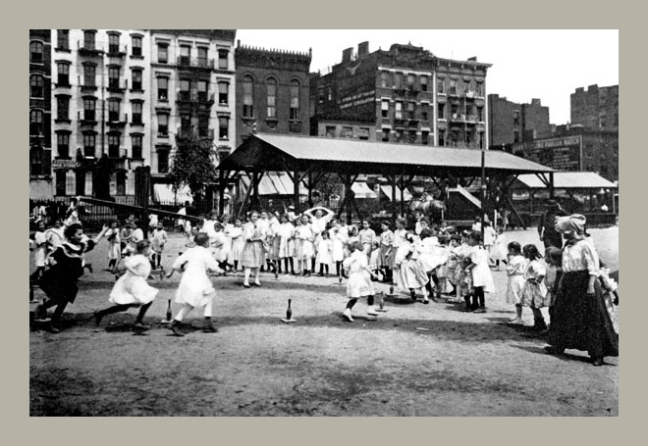In the United States of America, facilitation of play has been a public responsibility for the entirety of the 20th century. In the Streets Without Cars studio, will establish the need for play space within the public domain, hence it is important to understand the discourse behind playgrounds and the drivers that allow for their creation.
There have been proven developmental and social benefits associated with childhood play, best represented in the United States by public playgrounds.[1] However, politicians and policy makers were not always interested in this, with playgrounds originally constructed as a necessary public safety measure.
At the turn of last century, progressive liberal reformers in line with Theodore Roosevelt and New York mayor, Seth Low, acknowledged the need for publicly funded outlets for poorer children to access education, health services and daycare. This resulted in the construction of schools and settlement houses.[2] Settlement houses were converted properties run by middle class volunteers as a form of daycare for children of the working families of the tenements. The play spaces these houses included were fenced off green spaces sometimes featuring a sand pit and swing set. The settlement houses were designed to keep children safe and out of trouble.
However it was established by 1901 that there were far too many children playing on the streets, causing high youth delinquency, an increased number of play-related car accidents, and a public nuisance.
A study conducted in New York City in 1901 revealed that there were 183 minors killed in moving vehicle related accidents, an additional 381 incidents were reported where the child survived. This tendency had led three years previously to the establishment of a group run by New York settlement house workers, the Outdoor Recreation League, which had already opened 9 privately owned playgrounds. In 1902, the city acquired all of them. Later that year, Seward Park became the first publicly commissioned play ground in New York. Key features of the park included an athletics space for boys, children’s play area with swings and sandpit for girls and younger children, green space, and public baths. The park was well received with over 20,000 people attending the opening ceremony.[3]
After World War I there was very little improvement in play spaces, however more playgrounds continued to be built following the playground typologies seen at Seward Park:[4]
Athletic fields
For boys over 14
Competitive track and field sports
Lockers and toilets
Baseball fields
Maintained lawn
Screening of danger zone and bleachers
Boys playground
For boys under 14
Swings
Seesaws
Slides
Space for ball games
Girls playground
Same as boys
Sand pit
More open space for free games
In the 1930s, Carl Theodor Sorensen, a Danish landscape architect, thought of providing scrap materials to children to create their own environment as a new form of play. The first playground following this philosophy was opened in Denmark in 1943. The first junk playground was opened in the United States during the 1970s in Huntington Beach, California. This was a significant step towards establishing the importance of free play, where children were able to design their own environment. By this point there was an awareness of the relationship between play and learning, with the purpose of playgrounds no longer a response to the outmoded idea of children as public nuisance.[5]
However, through a history of regulations for playground safety, such as policies to regulate the speed of merry-go-rounds, swing safety harnesses and rubberized play surfaces, we see less adventurous play facilities emerging. Parents are also taking a more hands-on role in directing children how to play, removing the learning and developmental benefits of play in the process.[6]
In 2010, the Rockwell Group completed the Imagination Playground in New York. This playground differs from typical playground design thanks to the assortment of proprietary Rockwell Blocks made available throughout the playspace. These large foam blocks were designed to maximise design options for children to construct their own environment. They mimic the flexibility of the junk playground without requiring the space and insurance premiums that go with it. Other facilities within the playground are intended to be used in conjunction with the Rockwell Blocks: water, sand an timber climbing frames to name a few.[7]
While the limited flexibility of the 15 standard Rockwell Blocks does not provide the same free play experience as the junk playground, the designer of the blocks, David Rockwell, also identifies the necessity for parents to limit their controlling role in their children’s play. Carers within the Imagination Playground are thereby instructed to ensure parents leave their children alone to play as they please. The key innovation of this project is that it recognises the difficulty of designing a playground to freely stimulate children. It is in fact the children’s ability to reshape and construct their own environment that ensures the success of a play space.

Footnotes
- Interview with Joe Frost; What’s wrong with America’s playgrounds; American Journal of Play; 2008.
- Seward Park history; NYC Parks.
- Ibid.
- Playgrounds in parks; NYC Parks.
- Kurt Kohlstedt; Urban Adventure Playgrounds: Cool Places Too Few Kids Play; Web Urbanist.
- Hannah Rosin; The Overprotected Kid; The Atlantic; March 2014.
- Rebecca Mead; The State of Play; The New Yorker; July 2010.
Images sources
- Benefits of play, author’s own image.
- Seward Park site plan, copyright Harvard University. Image sourced from Harvard Art Museums.
- Seward Park pavilion, copyright Harvard University. Image sourced from Harvard Art Museums.
- Imagination Playground #1, copyright Rockwell Group.
- Imagination Playground #2, copyright Rockwell Group.
- Imagination Playground #3, copyright Rockwell Group.
- Imagination Playground $4, copyright Rockwell Group.





